Posted: January 24th, 2015 | 2 Comments »
The lucky folk of Canberra have this exhibition to attend….
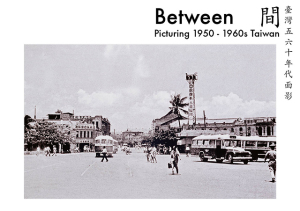
間:臺ç£äº”å…å年代é¢å½±
Between – Picturing 1950-1960s Taiwan
Politics has had complex effects on the cultural life of Taiwan in the twentieth century. These forty-four works, curated from the collection of the National Museum of History (Taipei), offer subtle observations of Taiwan in the 1950s and 1960s, from the perspectives of fifteen artists and photographers, as fresh and curious witnesses to lives in flux.
Featuring photography, sketches and prints by: Chang Tsuan-chuan, Chao Erh-tai, Chen Shih-an, Cheng Shang-hsi, Hsi Teh-chin, Kao Shan-lan, Lin Chih-hsin, Liu, An-ming, Teng Nan-kuang, Tsai Hui-ch’un, Tsai Hui-feng, Tsai Kao-ming, Tu Feng-hui, Yang Chi-hsin, Yu Ju-chi.
Curated by Dr Olivier Krischer (Australian Centre on China in the World), Dr Hsieh Shih-ying è¬ä¸–英 (National Museum of History)
Exhibition dates: 6 January – 3 April, 2015
Gallery hours : 9am-5pm, Monday to Friday
Download the exhibition information
Opening Reception
The exhibition will be opened by Dr Yui-tan Chang (Director, National Museum of History, Taipei) at 5pm on Tuesday 6 January.
Image credit: Yu Ju-chi, Historical Image of Taichung Station (12-11), c.1960, gelatin silver print, 45 x 66cm. Courtesy the National Museum of History, Taipei.
This exhibition is made possible through the generous loan of works from the National Museum of History, Taipei. The Australian Centre on China in the World also gratefully acknowledges the support of the Ministry of Culture, ROC (Taiwan), and the Taipei Economic and Cultural Office in Australia.
Posted: January 23rd, 2015 | No Comments »
Von Sternberg’s 1941 The Shanghai Gesture is, without doubt, the most hyper real portrayal of old Shanghai’s casinos and Badlands. I must have watched the film a hundred times. What I didn’t know till the other day is that murals that dot the walls of the casino and Mother Gin Sling’s (Ona Munson in yellow face) casino and rooms were done by the Chinese-American actor Keye Luke. Canton born Luke was about the best known Chinese face in cinema before the war in all those Charlie Chan and Mr Moto movies and had a career that went on long after too. He was also a talented painter. In fact, after growing up in Seattle, he first worked in the film business as a commercial artist and a designer of movie posters. He did a lot of murals including some for the inside of Graumann’s Chinese Theater in Los Angeles. Luke was hired by von Sternberg to do murals for The Shanghai Gesture and commented that,
‘…it was like painting the Great Wall of China. It was a huge room – a dining room – and there was four sides and one a plate glass mirror. It was very, very effective.’
Here then some scenes from the movie with the mural in the background….
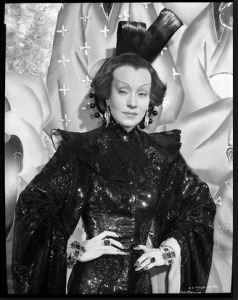
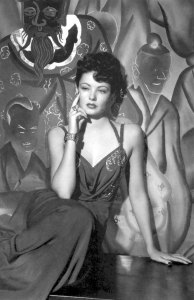
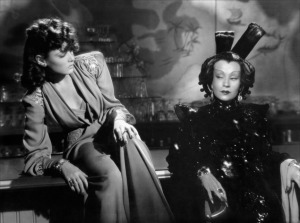
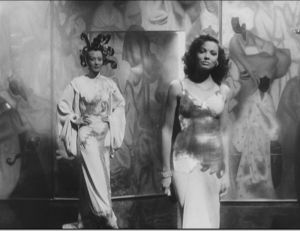
Posted: January 22nd, 2015 | No Comments »
I blogged yesterday on Harry Hervey, the man who wrote the original treatment for Josef von Sternberg’s Shanghai Express and a number of other Far-East and China related movies. He was also a writer and his book Where Strange Gods Call – Pages Out of the East, from 1924, is now largely forgotten – but well worth remembering. The book is an account of the author’s travels in Hawaii, Japan, China (though I don’t think he actually visited Shanghai), the Malay Archipelago, Indonesia and the South Seas with vignettes portraying the exotic people, sights and cultures he found there accompanied by illustrations from Christopher Murray (about whom I know nothing).
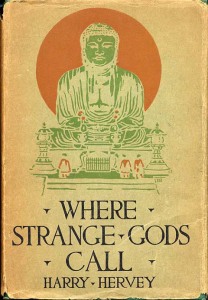


Posted: January 21st, 2015 | 2 Comments »
Re-reading Josef von Sternberg’s very funny autobiography, Fun in a Chinese Laundry, the other day I was reminded that the notion to make the film Shanghai Express came to von Sternberg from a one page idea from the writer Harry Hervey (1900-1951). As it’s such a great film, a Shanghai film, the film where Marlene Dietrich and Anna May Wong appear together, and where Marlene immortalises Shanghai Lily, it seems worth knowing a little more about Hervey.

Harry Hervey
Hervey had a strong interest in China and Asia related stories – his film credits, and he dated back to the silent era, as a story outliner and writer include Madame Butterfly (a Japanese set police story featuring a very young Cary Grant), The Road to Singapore (with Bing and Bob obviously), Night Plane from Chungking, and Peking Express (Joseph Cotten fleeing the Commies).
Hervey also wrote novels – several also set in Asia – most notably Congai: Mistress of Indo-Chine, the story of an Indo-Chinese girl (congai in Vietnamese). Hervey had travelled extensively in French Indo-China in the mid-1920s and written it up in his travelogue Travels in French Indo-China. He also visited China – photographed in 1926 (below) looking far more dapper than most visitors to Beijing these days (reminding us how fleece, Gortex and trainers have cheapened our world immeasurably)..


Posted: January 20th, 2015 | No Comments »
I’ve found that one of the most useful aspects of having a blog like this is that I can occasionally throw out questions and conundrums I’ve been unable to solve and find people who know the answers. Here’s one I’ve not got very far with…
The film director Josef von Sternberg was born Jonas Sternberg in Austria in 1894 to a Jewish family. He obviously became a film director and crops up repeatedly on this blog for his excellent autobiography Fun in a Chinese Laundry and his movies Shanghai Express, The Shanghai Gesture and Macao. He added the “von” to his name in 1925 when he was starting out in the film business.
In his autobiography he recounts that “many years later” he met the Count Leopold von Sternberg in Shanghai – a Czech and the most well known genuine von Sternberg in the world at the time. The Count apparently asked to meet Josef in Shanghai to thank him for making his name famous. However, I can’t find any reference to the Count visiting Shanghai. His wife, Cecilia, wrote an autobiography of her life with the Count, The Journey (1977) but doesn’t mention China or Shanghai at all. The photo below shows the Count and Countess in 1934 (“some years later”) relaxing on the beach at Waikiki, Hawaii in 1934 on what was supposedly their first “American stop” on a trip from Europe to the USA. This indicates that they came via Suez and Asia to America, rather than across the Atlantic and then overland, and so could well have previously stopped in Shanghai and met Josef as he claims in his autobiography. I like the picture below as it features a Chinese parasol, another favourite motif of this blog.
If anyone has anymore information on the Count in Shanghai I’d love to know?
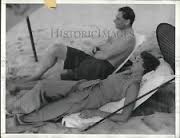 on the beach at Waikiki, 1934
on the beach at Waikiki, 1934
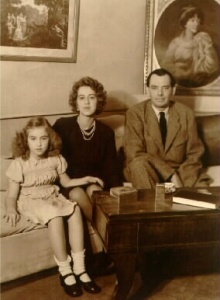 Count Leopold, Countess Cecilia and their daughter Diana
Count Leopold, Countess Cecilia and their daughter Diana
Posted: January 19th, 2015 | No Comments »
Regular readers will know that many China Rhyming posts are slightly obscure. Here’s one of those – by way of explanation I’ve just visited Essaouira in Morocco, which used to be called Mogador, which is the town that Marlene Dietrich’s character, wandering showgirl Amy Jolly, arrives in at the start of her movie Morocco (1930), directed by Josef von Sternberg (two years before they did Shanghai Express) and from the 1927 Benno Vigny novel Amy Jolly, die Frau aus Marrakesch (which became Mogador in the movie). So visiting Mogador I re-watched the movies and remembered that Amy is, in her apartments in the town, alone with few of her belongings except a Chinese and African doll…what can these mean?
Hard to say but a few theories – the academics appear to have none except that perhaps the African doll presages Dietrich’s Hot Voodoo number in Blonde Venus – but I’m not convinced by that. More likely is that Von Sternberg, a great fan of China (Shanghai Express came later as did 1941’s The Shanghai Gesture and 1952’s Macao, while his autobiography was called Fun in a Chinese Laundry and dwells on his Shanghai and Chinese experiences closely) dropped the doll in the shots to show Amy’s previously wandering proclivities. of course showgirls wander and never return as the script goes with La Bessiere (a rich Frenchman played by Adolphe Menjou) talking to the ship’s deck officer:
La Bessiere: Good evening, officer.
Ship’s Deck Officer: Good evening.
La Bessiere: [Referring to Amy Jolly/Dietrich] Do you know who that woman is?
Ship’s Deck Officer: [Indifferently] A vaudeville actress, probably.
La Bessiere: Uh, just, uh, how do you know that?
Ship’s Deck Officer: Oh, we carry them every day. We call them ‘suicide passengers.’ One way ticket. They never return.
So perhaps we will never why Marlene (or Amy, whichever you prefer) had a Chinese doll – however, there was a real Amy Jolly who had been a showgirl and dancer and ended up a brothel madam in Agadir (rather nastily selling young girls – very young girls – to French Legionnaires). She was broke and wrote to Dietrich asking for money and, it seems, Marlene sent her some (the whole story is here) – sadly no pictures of the real Amy Jolly survive.
 Amy (Marlene) with her Chinese doll in Morocco
Amy (Marlene) with her Chinese doll in Morocco
Posted: January 18th, 2015 | No Comments »

The history of Chinese migrants in the UK, craft activities celebrating Chinese New Year, and cutting edge arts performances influenced by Chinese culture are among the highlights of early 2015 at the Horniman Museum and Gardens in Forest Hill, South London.
A new exhibition exploring the lives and experiences of the Chinese community in the UK opens on Saturday 17 January. Memories of China offers an insight into the history and contribution of Chinese migrants in the UK in the early 20th century, and their relationship to their homeland. It features artworks, videos and objects – from a compass and a cloisonné hotpot brought from Beijing, to statues of the three deities Fu, Lu and Shou (Happiness, Prosperity and Longevity) traditionally displayed in many Chinese homes and shops.
The exhibition is part of the British Chinese Workforce Heritage project, a three-year oral history project organised by Ming-Ai (London) Institute and funded by a £324,400 grant from the Heritage Lottery Fund. The project charts the waves of Chinese migration to the UK, from the earliest seafarers and traders to the tens of thousands of Chinese who served during the First and Second World Wars. The project also includes those who settled and built the Chinese communities and their experiences in a range of employment industries including laundry, catering, health care, traditional Chinese medicine and newer professions.
Alongside Memories of China, the Horniman is marking Chinese New Year with themed activities for children and families. From Monday 16 to Friday 20 February, Family Art Fun features craft activities inspired by the Chinese New Year, as well as the opportunity for visitors to help create a traditional Chinese Wishing Tree.
Adults can celebrate the Year of the Sheep with a contemporary twist at the Horniman’s Chinese Late on Thursday 26 February. The evening promises a night of cutting-edge art installations, films and performances by Chinese and international artists, revealing how Chinese culture has inspired artists around the world.
Memories of China opens on Saturday 17 January and runs to Sunday 12 April. Admission to the exhibition is free.
Tickets to the Chinese Late are on sale now.
Posted: January 17th, 2015 | 11 Comments »
I blogged a while back about the word “Tokyo” as slang for cocaine and its use in 1920s London in the second series of Peaky Blinders. It wasn’t a term I was familiar with and asked China Rhyming readers if it was an actual term from the time or just an invention of the scriptwriters? You didn’t disappoint – some responses:
probably e a custom mix from one of the Chinese drug dealers broadly speaking a mix of coke strychnine amphetamine and morphine.
Tokyo rose was cockney rhyming slang for nose, which would make sense…..
Cockney rhyming slang – Cocaine ==> Coke ==> Toke ==> Tokyo
one of the first chemists to synthesize methamphetamine was Japanese. In the series Tommy points out to Arther that Tokyo is used on race horses. I believe that “Tokyo†is slang for any kind of speed.
And, seemingly definitively, from some who’s father was a Bobby (cop) in the 1950’s, in London, and who’s Granddad was a Bobby in the 1920’s. Both spoke Cockney fluently, Tokyo was the slang for Coke, Meth, too much sugar… Pretty much anything that gave you crazy energy!
















